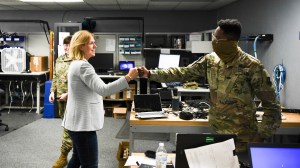
The Air Force Air Combat Command is embarking on a five-year unified communications transformation with the hopes of getting more than 90 percent of its users to a soft client computing solution, Chief Technology Officer Bill Marion tells FedScoop.
Marion tells us that over the next six months, the ACC will release a number of policies – namely a master plan for unified communications and implementation strategies – to lay out the architecture for the transition. He’d like 20 percent of users to be UC compliant within the first year or so.
“We fully believe in convergence and giving the device of your choice,” said Marion, who is based out of the command’s headquarters, Langley Air Force Base in Hampton, Va. “We want to compress decision cycles and get information out as efficiently as possible whatever the device may be.”
The ACC is one of 10 major commands within the Air Force and is the primary force provider of combat airpower to the warfighting commands, operating fighter, bomber, reconnaissance, battle-management and electronic-combat aircraft.
The command features approximately 98,000 active duty members and more than 11,000 civilians spread across the world, including Europe and the Pacific, creating a complex and diverse information technology need.
One of the parts of the unified communications strategy is an emphasis on online presence or, as Marion explains, as on Google like “that little green jelly bean that lets you know when someone is available.”
The idea, he says, is getting away from the old standard of desktop computers, email for communications and hardwired phones, but creating an environment where decisions can be made quicker and more efficiently.
For example, if a command employee needed authorization on a task and there were only three people with the authority to give authorization. Instead of sending each of those three people an email and waiting for a response, the employee could tag those people and, when they became available, seek the authorization.
“We want to fundamentally change the way we communicate,” Marion said.
The early signs are good. Marion tells us that there has been an overwhelming demand for mobility services throughout the command. He says the challenges going forward to implementation are part devices, part capability, part converged online space and working through vendor interoperability.
One of the other hurdles will be continuing to change the culture around communications. He believes that the ACC has been making waves in this regard and will cross a point in the next six to 12 months with more people becoming accustomed to the principles of unified communications.
What he didn’t mention that’s been a constant in mobility discussions of late: security.
“The vendors are doing a pretty good job of creating security models that work,” Marion said. “Security is important, to be sure, but our big priority is getting the whole platform in line with our networks so we have the resources to make sure this isn’t a one-off solution.”
To help with the security, though, Marion has taken an approach that is becoming common around government security when it comes to mobility: Having devices act essentially as high-end readers without the ability to download the data. The idea being if they get compromised there is nothing incriminating on them.
“The key will be to worry about the applications and if, say, a laptop gets lost, then its just the device that is lost and its not that big a concern.”




